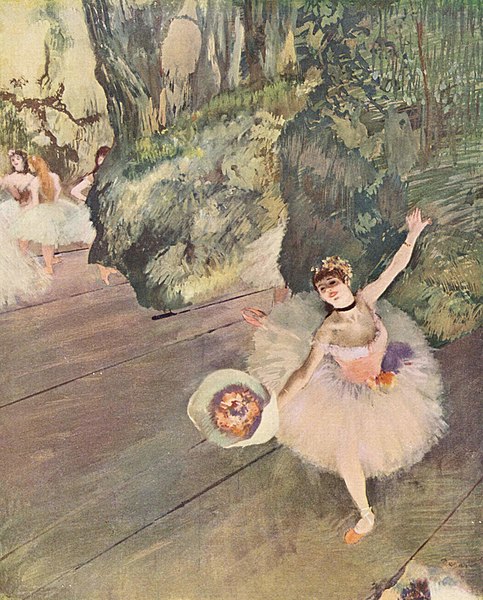Impressionism
If you look at the artwork from the Impressionist period first, you'll be able to contextualise and appreciate the driving force behind Impressionist music.
So here's some of the most prominent, idiosyncratically Impressionist pieces of visual art for you to analyse.
Paul Cézanne in his Impressionist period:

Edgar Degas painting dancers:
Claude Monet, the most famous: 

Some key elements of the aesthetic that Impressionist painters created are:
- Short thick paintstrokes or dabs. They would paint quickly and ignore details.Painters used a technique called impasto to lay it on thick which gives the finished piece rather obvious paint strokes and a tactile texture.
- Black paint wasn't used often because it defined too much, when the whole idea was to leave things deliberately vague and undefined.
- Paint was applied on paint that wasn't yet dry, so colours would run and merge and further add to the undefined result of the painting
- Lighting conditions were manipulated to better assist the vagueness of the image - obscuring detail using flooding sunlight or shadowy dusk lights.
So in conclusion, the artwork of the impressionists was purposefully done to create an overall sense of an image, using texture, light, shadow and colour to give a "feel" (or impression!) of an image or scene.
How the Musicians did it.
Or rather, how did composers do it? Because after all, the music was composed with this in mind. The musicians had to make it come to life.
The composers who were the big names in Impressionist music were:
Claude Debussy
Maurice Ravel
Modest Mussorgsky
Erik Satie
Enrique Granados
Characteristics of Impressionist Music included:
Writing about "Things".
Composers enjoyed certain things in the Impressionist period - an obsession with Asia and the Arab region, giving way to pieces like Arabesques and Sheherezade, idyllic scenes, like Debussy's Afternoon of a Deer, which we look at later, Nocturnes which were all about the twilight and the night time, or Mussorgsky's "Pictures at an Exhibition" which describes a guy looking at pictures in turn in a gallery.
Use of Timbre (or tone-colour)
Composers used the full complement of the orchestra, including percussion and harps, to create their musical picture.
Harmonics and Pizzicato were used, as was further techniques such as Con Sordino, Sul Ponticello and Sul Tasto. Tremolando was also employed to add to the blurry and hazy effect.
Piano music used the sustaining pedal extensively to blur the harmonies.
Melody & Harmony
Composers were not limited to major and minor scales, they also used pentatonic and whole-tone scales, modes even.
The tonality of the music therefore could be unclear, or it could be ever-changing.
Chords were developed to include dissonances and not restricted to triads and dominant sevenths.
Melodic intervals included augmented intervals, such as the tritone (augmented 4th - for you Highers who are like whit!? that is like the space from C-F -which is a 4th- except the F becomes sharp, which augments it by a semitone, just stretching the gap a wee extra bit).
Here's a piece of Debussy's music that just homes in on 3 bars, and the sort of thing he does to create a sense of what the piece is about:
Hit play on the video. The very opening section relates to the music.
Rhythm/Tempo
The rhythms and tempos of an impressionist piece of music were subject to the same avoidance of depth and rigidity so naturally you can assume that tempo was subject to change in a piece of music. The composers often wanted players to use Rubato at their discretion, but would often specify changes with a marked Rallentando (slow down), Meno Mosso (less movement), Allargando (Broader) or other variations in tempo.
Dynamics
Not quite as dramatic as the Romantic period, these guys liked to use the softer, gentler family of dynamics. Even looking at the piece above you can see the dynamics are all in the quiet zone with some accents to punctuate the music.
Impressionist Playlist.
As you are studying for your other subjects, put some impressionism on in the background. It's one of these unintrusive styles of music, that you're either listening really intently to and picturing what's going on, or you're barely aware of it.
If you want to listen intently (which you should at some stage) try to identify some of your concepts in the music.


No comments:
Post a Comment
All comments will be moderated.